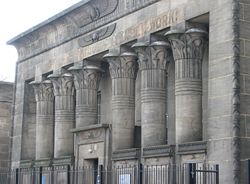
Temple Works
Encyclopedia

Flax
Flax is a member of the genus Linum in the family Linaceae. It is native to the region extending from the eastern Mediterranean to India and was probably first domesticated in the Fertile Crescent...
mill in Holbeck
Holbeck
Holbeck is a district in Leeds, West Yorkshire, England.The district begins on the southern edge of the Leeds city centre and mainly lies in the LS11 Leeds postcode area. The M1 and M621 motorways used to end/begin in Holbeck. Now the M621 is the only motorway that passes through the area since...
, Leeds
Leeds
Leeds is a city and metropolitan borough in West Yorkshire, England. In 2001 Leeds' main urban subdivision had a population of 443,247, while the entire city has a population of 798,800 , making it the 30th-most populous city in the European Union.Leeds is the cultural, financial and commercial...
, West Yorkshire
West Yorkshire
West Yorkshire is a metropolitan county within the Yorkshire and the Humber region of England with a population of 2.2 million. West Yorkshire came into existence as a metropolitan county in 1974 after the passage of the Local Government Act 1972....
, England
England
England is a country that is part of the United Kingdom. It shares land borders with Scotland to the north and Wales to the west; the Irish Sea is to the north west, the Celtic Sea to the south west, with the North Sea to the east and the English Channel to the south separating it from continental...
. It was designed by Joseph Bonomi the Younger
Joseph Bonomi the Younger
Joseph Bonomi the Younger was an English sculptor, artist, Egyptologist and museum curator.-Early life:Bonomi was born in London into a family of architects...
and built by John Marshall between 1836 and 1840. Temple Works is the only Grade I listed building in Holbeck.
Temple Works, also known as Temple Mill, was based on the Temple of Horus at Edfu
Edfu
Edfu is an Egyptian city, located on the west bank of the Nile River between Esna and Aswan, with a population of approximately sixty thousand people. For the ancient history of the city, see below...
in Egypt
Egypt
Egypt , officially the Arab Republic of Egypt, Arabic: , is a country mainly in North Africa, with the Sinai Peninsula forming a land bridge in Southwest Asia. Egypt is thus a transcontinental country, and a major power in Africa, the Mediterranean Basin, the Middle East and the Muslim world...
with a chimney designed in the style of an obelisk
Obelisk
An obelisk is a tall, four-sided, narrow tapering monument which ends in a pyramid-like shape at the top, and is said to resemble a petrified ray of the sun-disk. A pair of obelisks usually stood in front of a pylon...
. Marshall's inspiration for the design of Temple Works was his interest in Egyptology
Egyptology
Egyptology is the study of ancient Egyptian history, language, literature, religion, and art from the 5th millennium BC until the end of its native religious practices in the AD 4th century. A practitioner of the discipline is an “Egyptologist”...
. When it was built it was said that Temple Works was the biggest single room in the world. An unusual feature of the Temple Works building is that sheep used to graze on the grass-covered roof. This served the purpose of retaining humidity in the flax mill to prevent the linen
Linen
Linen is a textile made from the fibers of the flax plant, Linum usitatissimum. Linen is labor-intensive to manufacture, but when it is made into garments, it is valued for its exceptional coolness and freshness in hot weather....
thread from becoming dried out and unmanageable.
A planning application dated July 2005 proposed to partly demolish, refurbish, and extend the mill to form a retail centre, offices, cafes, 75 flats and parking. On 8 December 2008 a stone pillar in the mill's facade collapsed. A slab of millstone grit fell onto the pavement in Marshall Street and the roof parapet above the pillar bowed out. English Heritage
English Heritage
English Heritage . is an executive non-departmental public body of the British Government sponsored by the Department for Culture, Media and Sport...
advised on a strategy for repairs; their spokesman said that the building was "probably the finest example of a carved stone elevation in the whole region."
In late 2009 the building was opened as an arts centre, with an initial exhibition and tour as part of Leeds Light Night
Light night
Light Night is a cultural event which first happened in the city of Leeds in October 2005, as part of the launch of the region-wide Illuminate Cultural Festival....
on 9 October.

